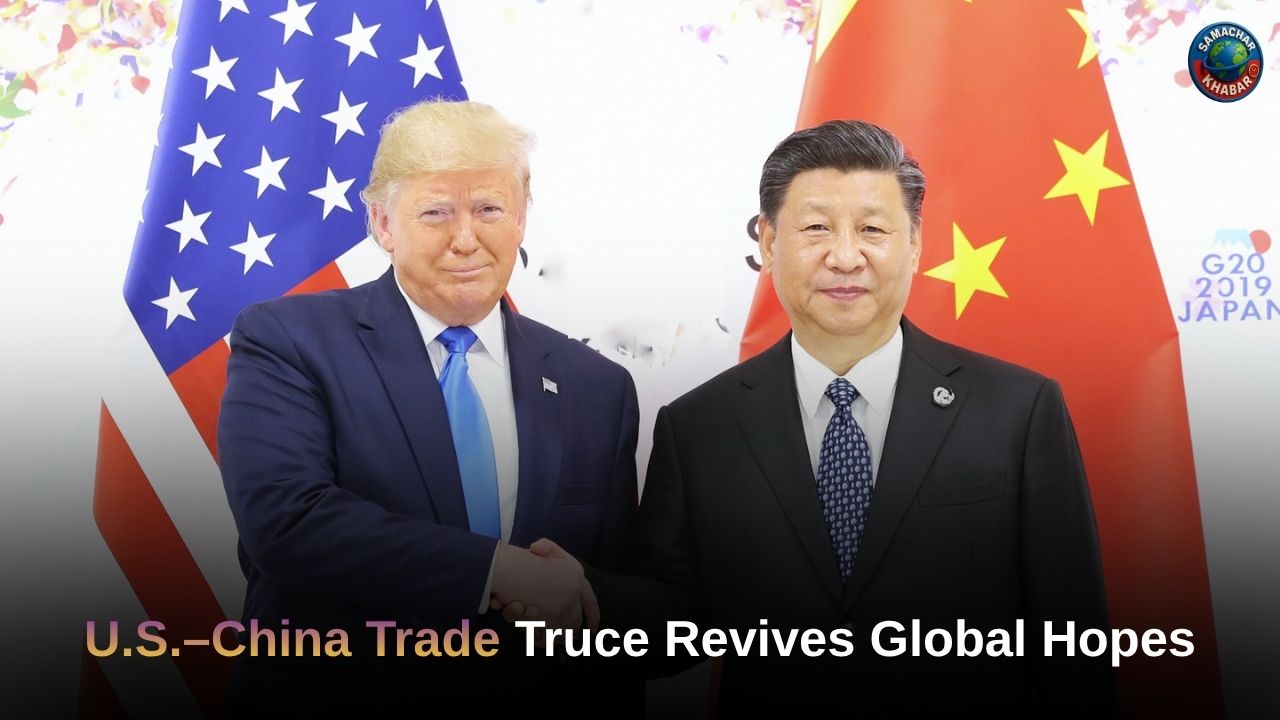In a long-awaited diplomatic milestone, U.S. President Donald Trump and Chinese President Xi Jinping have announced a sweeping one-year trade agreement following a high-stakes meeting in Busan, South Korea. The deal includes lower tariffs on Chinese imports, the postponement of China’s rare earth export controls, and new commitments on fentanyl restrictions and semiconductor discussions. The breakthrough, which comes after months of tense economic confrontation, has been described by Trump as an “amazing meeting” and could mark the beginning of a new phase in U.S.–China relations.
Key Highlights of the U.S.–China Trade Breakthrough
- Lower Tariffs Announced: Trump confirmed that the United States will reduce certain tariffs on Chinese goods, including cutting the fentanyl-related duty from 20% to 10%.
- Rare Earths Roadblock Removed: Xi Jinping agreed to postpone sweeping export controls on rare earth minerals, a critical step to stabilize global supply chains.
- One-Year Trade Agreement: Both nations reached a one-year framework deal to review progress annually, with intentions for a long-term partnership.
- Semiconductor Talks to Resume: U.S. chipmaker Nvidia will discuss chip exports with China, though the most advanced technologies remain excluded.
- No Concessions on Taiwan: Trump clarified that Taiwan “never came up” during the talks, dispelling fears of potential compromises.
- Mutual Visits Planned: Trump will visit China in April, with Xi expected to make a reciprocal visit to Washington later this year.
- New Areas of Cooperation: China emphasized cooperation in AI, anti-money laundering, telecom fraud, infectious disease response, and illegal immigration.
Trump’s Asia Tour Ends with a Landmark Deal
Trump’s Asia trip began in Malaysia, where he witnessed a peace deal between Thailand and Cambodia after months of border clashes. He then visited Japan, meeting Prime Minister Sanae Takaichi to sign two major agreements , one to boost rare earth production and another dubbed the “New Golden Age Deal,” reaffirming existing trade ties.
The tour culminated in South Korea, where Trump attended the APEC Business Leaders Summit in Gyeongju and later met Xi Jinping at Busan Airport. This was their first face-to-face meeting since Trump’s re-election and marked a critical moment after years of escalating tariffs and mutual distrust.
An ‘Amazing’ Meeting that Changed the Tone
Aboard Air Force One after the summit, Trump told reporters, “It was an amazing meeting , on a scale of 0 to 10, it was a 12.” He praised Xi as “a great leader of a great country” and said both nations would sign the deal “pretty soon.” Trump emphasized that the agreement had “not too many stumbling blocks” and expressed optimism that it would “go long beyond a year.”
The U.S. President described the new trade understanding as an “outstanding group of decisions,” highlighting the settlement of the rare earth dispute and a significant reduction in fentanyl-related tariffs. Trump added that Xi had pledged to “work very hard” to curb the export of opioid precursors, calling it a “real step forward” in public health cooperation.
Xi Jinping’s Call for Constructive Cooperation
Chinese state media struck a measured tone following the meeting. According to People’s Daily, Xi urged both countries to “refine and finalise follow-up work as soon as possible” and deliver “tangible results.”
Xi stressed that “recent twists and turns in China–U.S. economic and trade relations show that trade should be the ballast of the relationship, not a point of conflict.” He cautioned both sides against entering a “vicious cycle of mutual retaliation” and instead called for practical collaboration in fields like artificial intelligence, financial security, and disease control.
While Beijing did not confirm all details of the trade deal, it acknowledged an agreement to “strengthen cooperation in trade, energy, and cultural exchanges,” suggesting cautious optimism in China’s official narrative.
Why This Meeting Matters for the Global Economy
The Busan summit comes at a fragile time for global trade. Earlier this year, Trump imposed 145% tariffs on Chinese goods, prompting Beijing to retaliate with a 125% levy , a near trade embargo that rattled global markets. The newly announced truce provides breathing room for manufacturers, technology firms, and farmers on both sides.
The rare earth agreement is particularly significant. China controls the majority of global rare earth production , essential for defense, renewable energy, and electronics manufacturing. Its decision to suspend export restrictions eases fears of supply shortages, especially in Western industries.
Also Read: A Closer Look at the US Commerce Secretary India Trade Deal 2025
The U.S., meanwhile, faces domestic pressure to stabilize trade channels and protect its agricultural and manufacturing sectors, which were hit hard during the tariff war. Trump’s decision to tone down his rhetoric and reduce certain tariffs is being viewed by analysts as a pragmatic move ahead of his April visit to China.
Challenges Still Linger Beneath the Optimism
Despite the apparent progress, experts caution that unresolved issues remain. Technology export restrictions, especially involving advanced semiconductors, continue to strain relations. Washington has refused to ease controls on high-end chips vital for AI and quantum computing.
Similarly, the transfer of TikTok’s U.S. operations to a domestic consortium remains pending, signaling that broader tech tensions persist. And while Trump denied any discussion of Taiwan, the U.S.’s continued defense commitments to Taipei remain a sensitive point for Beijing.
Dennis Wilder, former CIA head of China analysis, noted that the current framework deal sets the stage for detailed negotiations led by U.S. Treasury Secretary Scott Bessent and Chinese Vice Premier He Lifeng. Analysts like Han Shen Lin of The Asia Group believe the fentanyl tariff cut addresses China’s long-standing grievances while setting expectations for further tariff reductions at future summits.
A Defining Moment in the U.S.–China Relations
The Trump–Xi meeting in South Korea may not have produced a final, signed deal yet, but it has reset the tone between Washington and Beijing after years of confrontation. Both leaders signaled a readiness to cooperate, even as fundamental differences endure.
For now, global markets have responded with cautious steadiness, U.S. stock futures and most Asian indices held firm or dipped slightly following the announcement. The coming months will test whether this fragile calm can evolve into lasting stability.
As Trump said after leaving Busan, the talks were “something very exciting for everybody.” For the world’s two largest economies and for global investors watching closely that excitement carries the hope of a new era of economic balance rather than rivalry.
The Eternal Agreement Beyond Worldly Deals
While nations like the U.S. and China celebrate diplomatic trade deals, a far greater divine agreement once took place ; the eternal covenant between Kaal (the ruler of 21 universes) and the Supreme God Kabir Sahib, the Creator of all souls.
According to the divine knowledge revealed by Tatvdarshi Sant Rampal Ji Maharaj, Almighty Kabir Sahib Ji had promised that in Kalyug, when all false spiritual propagators would exhaust their scriptures and the true path would fade, He Himself would descend to restore Sat Bhakti , the true devotion that leads souls to eternal peace and liberation (Satlok).
Today, that divine prophecy stands fulfilled. Purna Parmatma Kabir Sahib Ji has appeared in the form of Sant Rampal Ji Maharaj Ji, who is imparting authentic spiritual knowledge based on our holy scriptures and guiding humanity toward freedom from the endless cycle of birth and death. His teachings emphasize that true devotion not only grants eternal salvation but also brings peace and happiness in this very life.
To understand this divine knowledge in depth, visit www.jagatgururampalji.org
and watch the enlightening discourses on YouTube Channel – Sant Rampal Ji Maharaj
FAQs on the U.S.–China Trade Deal
1. What is the new U.S.–China trade deal announced in South Korea?
It’s a one-year framework agreement between Trump and Xi to lower tariffs, pause rare-earth export controls, and enhance cooperation on fentanyl, AI, and semiconductors.
2. How does the deal impact global markets?
The trade truce eased fears of a prolonged tariff war, stabilizing rare-earth supplies and restoring investor confidence across technology, manufacturing, and agricultural sectors.
3. What key tariff changes were made by the U.S.?
President Trump reduced the fentanyl-related tariff from 20% to 10% and announced a general cut in tariffs on Chinese goods to around 47%.
4. Did the meeting address sensitive issues like Taiwan or TikTok?
Trump confirmed Taiwan was not discussed. However, unresolved tech disputes, including semiconductor exports and TikTok’s U.S. ownership, remain major points of tension.
5. What’s next for U.S.–China relations after the Busan summit?
Both nations plan reciprocal visits, Trump to China in April and Xi to Washington later this year, to review progress and pursue longer-term trade stability.

















